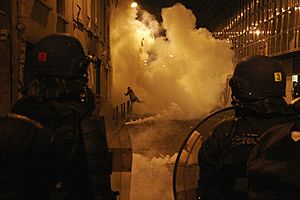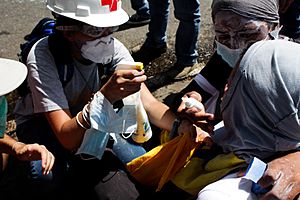Tear gas facts for kids
Tear gas is a name for several special chemicals. It's not actually a gas, but tiny powders or a fine mist of liquid. These chemicals are acidic and cause pain in the eyes. Tear gas can make it hard to see for up to 45 minutes. Police often use tear gas to control large groups of people.
Two common chemicals in tear gas are phenacyl chloride (CN) liquid and CS powder. Another chemical called pepper spray works in a similar way and is also used to control crowds.
Tear gas is a type of chemical weapon. It was used in World War I. Later, in 1992, a treaty called the Chemical Weapons Convention made it against the rules to use tear gas in wars. However, this treaty does not stop police from using it to control riots.
Why Using Tear Gas Can Be Risky
Using tear gas can cause problems. The small containers of tear gas are often thrown, and they can hit people and cause injuries. There have been reports of serious injuries, including nerve damage and even the need for surgery, from tear gas shells. Young people have also gotten head injuries.
If tear gas touches the skin directly, it can cause chemical burns or allergic reactions. Right after someone is exposed, they might get skin irritation. But there can be problems later too. People who have breathing problems, like asthma, might need medical help, sometimes even needing to go to the hospital.
If CS gas touches the skin, it can cause chemical burns or skin allergies. When people are hit very close up or get a lot of tear gas in their eyes, it can damage the eye. This damage can lead to a lasting loss of clear vision. Being around tear gas often or in large amounts can also increase the risk of breathing illnesses.
Related pages
Images for kids
See also
 In Spanish: Gas lacrimógeno para niños
In Spanish: Gas lacrimógeno para niños





